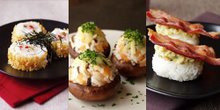Unusually for Japanese food, sushi can be eaten either by hand or by chopsticks. Traditionally, one should start with white-fleshed or milder-tasting items and proceed into darker, stronger-flavored varieties later. Only the fish (not the rice) should be dipped into soy sauce, which should be used sparingly. In top-end sushi restaurants, it is considered bad form to request or add extra wasabi, as the chef has (or should have) already placed a suitable amount in each morsel.
Many sushi restaurants offer fixed-price sets, selected by the chef from the catch of the day. These are often graded as ume (梅, ume), take (竹, bamboo) and matsu (松, pine), with ume the cheapest and matsu the most expensive.
In Japan, staff in sushi restaurants often employ a complex code-like vocabulary, where alternate words are substituted for common items. For example, egg is called gyoku ("jewel"), soy sauce is called murasaki ("purple") and the bill is known as o-aiso ("courtesy", "compliment"). The code words vary from place to place and often evolve locally to incorporate puns: for example, shako (giant clam) might be called garēji (garage), because the Japanese word shako can also refer to a vehicle depot. These terms would not be used, or even understood, in other contexts, but regular patrons may pick up and use this specialized terminology themselves while dining in the restaurant.
skip to main |
skip to sidebar

Sushi Sushi Sushi Sushi Sushi Sushi Sushi Sushi Sushi Sushi Sushi Sushi Sushi Sushi Sushi Sushi Sushi Sushi Sushi Sushi Sushi Sushi Sushi Sushi Sushi Sushi Sushi Sushi Sushi Sushi Sushi Sushi Sushi Sushi Sushi Sushi Sushi Sushi Sushi Sushi Sushi Sushi Sushi Sushi Sushi Sushi Sushi Sushi Sushi Sushi Sushi Sushi Sushi Sushi Sushi Sushi Sushi Sushi Sushi Sushi Sushi Sushi Sushi Sushi Sushi Sushi Sushi Sushi Sushi Sushi Sushi Sushi
Sushi

Blog Archive
Other Blogs
Benfica
iPhone Apple
Portugal
AGLOCO
Paintball
Tuning
Suzuki GSX-R 600
Nikon D200
Flash Games
Squash
Monty Phyton
Sporting Clube Lourel
Home Equity Loans
E-Loan
Manchester United
Sporting Clube de Portugal
New York City
AGLOCO
Brad Pitt
just Cartoons
Spain
Casting
Microsoft's Xbox 360
PlayStation
Sushi
Christopher Rockefeller (Rocancourt)
Add Your URL
Add your blog
Iniciação à Fotografia
Initiation to the Photography
about Diet
Fight Science
Google Search
Free MP3
Download Movies
Cracks and Cheats
about diet